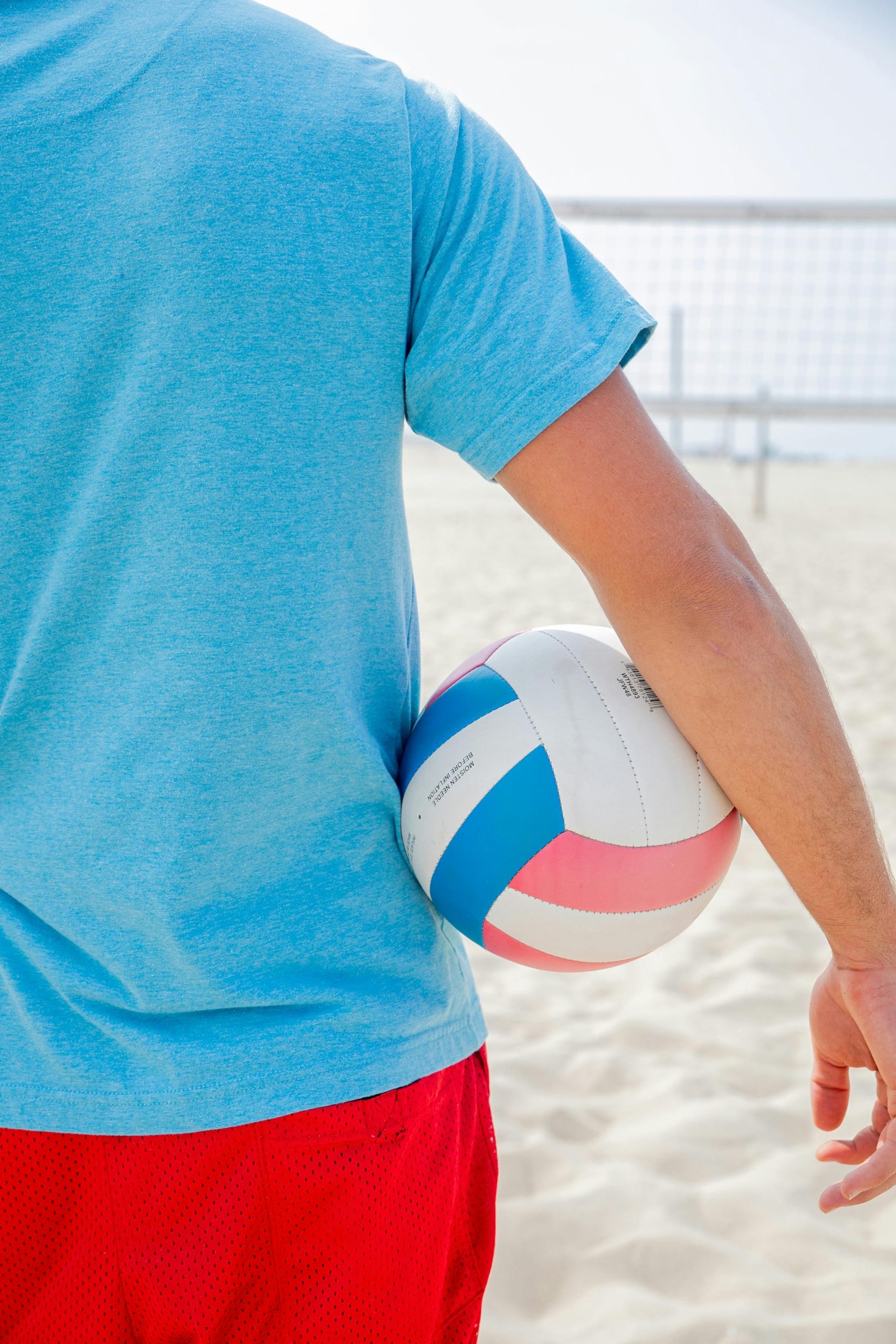There are certain rules that govern Beach volleyball. Some of the beach volleyball rules are different from indoor volleyball rules.
For those who are wondering what beach volleyball is all about and how it differs from indoor volleyball, well, beach volleyball is one of the most exciting volleyball sports. It is just a normal volleyball sport usually played outdoors (at the beach). As the name implies, beach volleyball is usually played at the beach.
But the quick difference is that the beach and indoor volleyball have slight differences in their rules. So whether you are a beginner or a professional indoor volleyball player, it’s important to understand the rules and regulations that govern beach volleyball before engaging in any beach volleyball match.

Basic Beach Volleyball Rules for Beginners
Let’s start by running beginners through some of the basic beach volleyball rules. These rules are basic and every beach volleyball player must know and get familiar with them:
What are the rules for set in beach volleyball? Below are some basic rules that govern beach volleyball:
- Serve: On the serve, you are not allowed to make contact with the end line, don’t touch your foot. Also, you may not make contact inside the court before you touch the ball.
- Out: The ball is out when it touches the antenna, ropes, posts, or the net itself outside the bands.
So basically, the ball cannot touch the antenna in any way or form. - Area: Official matches take place on rectangular sand courts 16 meters long and 8 meters wide. Around the playing area, there is a free space of at least three meters in each direction.
- Setting up an attack on the beach, your shoulders need to be perpendicular to the direction of where the ball goes.
Shoulder-square, the ball comes out clean. - Contact with the net by a player between the antennas during the action of playing the ball is a fault.
- An easy rule of thumb is don’t touch the net unless players may touch the post, ropes, or any other object outside the antenna.
Including the net itself, provided that it does not interfere with play.
So you can’t actually touch the net as long as it is outside of the antenna. - Faults in employing the ball. The ball is caught and/or thrown. It does not rebound from the hit.
You can open-hand set any ball, even the first ball over, as long as it is clean, meaning no double, catching, or throwing the ball.
Even though he didn’t touch the net, you’re not allowed to reach over the ball and make contact before the other teams allow you to.
This is for attacking now. Attacking is the same thing. - You’re not allowed to make contact if the ball is clearly beyond the plane of the net.
See also:
- Middle School Volleyball Rules (2024 Updated)
- 4 Best Position in Volleyball
- 7 Volleyball Conditioning Drills: A Comprehensive Guide for Players
- Volleyball Positions Diagram: Roles and Responsibilities (2024 updated)
- Volleyball Defense Drills 2024: New Improved
Common Faults in Beach Volleyball
Beach Volleyball Rules Explain
1. Team Structure
- Players per Team: Each team consists of 2 players (no substitutions allowed).
- No Rotations: Unlike indoor volleyball, players can stay in their preferred positions throughout the game.
2. Court Dimensions and Net Height
- Court Size: A beach volleyball court is 16m x 8m (smaller than an indoor court).
Net Height:
- Men: 2.43 meters (7 feet, 11 5/8 inches)
- Women: 2.24 meters (7 feet, 4 1/8 inches)
3. Scoring System
- Match Format: Matches are best-of-three sets.
- Set Points: The first two sets are played to 21 points, and the deciding third set (if needed) is played to 15 points.
- Win Margin: Teams must win by 2 points (e.g., 21-19).
- Rally Scoring: A point is scored on every rally, regardless of which team served.
4. Serving Rules
- Service Order: Teams alternate serves. The same player serves until their team loses the rally.
- Serve Position: The server must be behind the end line and inside the court’s width.
- One Attempt Only: Players get only one chance to serve correctly (no second attempts like in tennis).
5. Playing the Ball
- Touches Per Side: Teams are allowed a maximum of 3 touches to return the ball over the net.
- Clean Contact: Players must hit the ball cleanly (no catching, lifting, or throwing).
- No Open-Hand Dinks: Using open fingers to push the ball over the net is not allowed; use your knuckles or a closed fist instead.
6. Blocking and Attacking
- Blocking Counts as a Touch: If a player blocks the ball, it is considered one of the team’s three touches.
- No Back-Row Attacks: Since there are only two players, attacks can be made from anywhere on the court.
7. Ball in Play
- Boundary Lines: The ball is in if it lands on the line.
- Wind Adjustments: Players must adapt to outdoor conditions like wind and sun, which can impact the ball’s trajectory.
8. Court Switches
To ensure fairness regarding sun and wind conditions:
- Teams switch sides every 7 points in sets to 21.
- In the deciding set (to 15), teams switch every 5 points.
9. Sportsmanship
- No Coaching: Players must make all decisions and adjustments independently.
- Respect Opponents: Beach volleyball emphasizes fair play and good sportsmanship.
How is Beach Volleyball Different from Indoor Volleyball
There are not many differences between beach volleyball and indoor volleyball. The few differences between beach volleyball and indoor volleyball include:
| Beach Volleyball | Indoor Volleyball | |
| Team Size | 2 players | 6 players |
| Court Dimensions | 16m x 8m | 18m x 9m |
| Surface | Sand | Hardwood |
| Touch Rules | No open-hand dinks | Open-hand tips allowed |
| Environment | Outdoors, affected by wind/sun | Indoors, climate-controlled |
- Court Surface and Dimensions: Beach volleyball is played on sandy courts measuring 16 meters by 8 meters, while indoor volleyball is typically played on hardwood or synthetic courts measuring 18 meters by 9 meters.
- Team Composition: Beach volleyball teams consist of two players per side on the court, whereas indoor volleyball teams have six players.
- Substitutions: Beach volleyball allows only one substitution per set, whereas indoor volleyball allows unlimited substitutions.
- Scoring System: While both use a similar scoring system, beach volleyball requires teams to win by a two-point margin with no cap on the maximum score.
- Time-outs: In beach volleyball, each team has one 30-second technical time-out and one 60-second regular time-out per set, while indoor volleyball has different time-out regulations.
- Service and Rotation: In beach volleyball, the service order remains the same throughout the match, and players do not rotate positions after each rally, unlike in indoor volleyball.
- Coaching and Communication: Coaches are not allowed on the court during beach volleyball matches, requiring players to rely solely on their communication and decision-making skills.
These differences contribute to the unique challenges and dynamics of beach volleyball, making it a distinct and exciting variant of the sport.
See Also:
- Grass Volleyball Rules 2024: A Comprehensive Guide for Players
- Middle School Volleyball Rules (2024 Updated)
- New Improved Volleyball Tryout Drills – 2024
Beach Volleyball Court Dimensions and Surface
One of the most striking differences between beach volleyball and indoor volleyball lies in the court dimensions and surface. While indoor courts are typically made of hardwood or synthetic materials, beach volleyball courts are constructed on sand, adding an extra layer of challenge and unpredictability to every play.
The beach volleyball court measures 16 meters by 8 meters (52.5 feet by 26.2 feet), slightly smaller than the indoor court, which is 18 meters by 9 meters (59 feet by 29.5 feet). This compact size demands quicker reflexes and agility from players as they navigate the sandy terrain.
Moreover, the sand itself introduces a unique dynamic to the game. Players must adapt their footwork and movements to the shifting surface, which can lead to unexpected bounces and unpredictable ball trajectories. This aspect of the game tests players’ ability to anticipate and react swiftly, making for some truly spectacular rallies.
Team Composition and Substitutions in Beach Volleyball
In beach volleyball, teams consist of two players, as opposed to the six-player teams in indoor volleyball. This smaller team size places a greater emphasis on individual skill, communication, and teamwork between the two players on the court.
Substitutions in beach volleyball are also handled differently. While indoor volleyball allows for unlimited substitutions, beach volleyball teams are limited to one substitution per set. This rule adds an extra layer of strategy, as teams must carefully consider when and how to utilize their substitution to gain a tactical advantage.
Beach Volleyball Scoring and Time-out Rules
The scoring system in beach volleyball follows a similar format to indoor volleyball, with sets being played to 21 points (or 15 points in some tournaments). However, beach volleyball introduces a unique twist – teams must win by a two-point margin, with no cap on the maximum score.
Time-outs
Time-outs in beach volleyball are also handled differently. Each team is allowed one 30-second technical time-out per set, which can be called at any time during the set. Additionally, teams are allowed one 60-second regular time-out per set, which can be called when the ball is dead.
Beach Volleyball Service and Rotation Rules
In beach volleyball, the service order is maintained throughout the entire match, with teams alternating serves after every rally. This differs from indoor volleyball, where teams rotate their serving order after winning the right to serve.
Furthermore, beach volleyball players are not required to rotate positions after each rally, as is the case in indoor volleyball. This allows players to specialize in specific positions and develop unique strategies based on their strengths and weaknesses.
Coaching and Communication Rules Beach Volleyball
One of the most significant differences between beach volleyball and indoor volleyball lies in the coaching and communication aspects of the game. In beach volleyball, coaches are not allowed on the court during play, and players must rely solely on their own communication and decision-making skills.
This lack of direct coaching during the game adds an extra layer of mental toughness and strategic thinking for beach volleyball players. They must be able to quickly analyze the game situation, make split-second decisions, and communicate effectively with their partner to execute successful plays.
FAQs
How many players are on a beach volleyball team?
Beach volleyball teams consist of two players, as opposed to the six-player teams in indoor volleyball.
Can beach volleyball teams substitute players during a set?
Beach volleyball teams are limited to one substitution per set, adding an extra layer of strategy to the game.
What is the scoring system in beach volleyball?
Beach volleyball sets are played to 21 points (or 15 points in some tournaments), with teams required to win by a two-point margin and no cap on the maximum score.
Are coaches allowed on the court during beach volleyball matches?
No, coaches are not allowed on the court during beach volleyball matches, and players must rely solely on their own communication and decision-making skills.
How does the service order work in beach volleyball?
In beach volleyball, the service order is maintained throughout the match, with teams alternating serves after every rally.
Final Take
Beach volleyball has a unique set of rules that guides the players. There are rules for both players and coaches to adhere to during the matches.
During matches, both the players and the coaches are expected to abide by these rules. In summary, you must master the beach volleyball rules to avoid fouls and misconduct during the matches.




